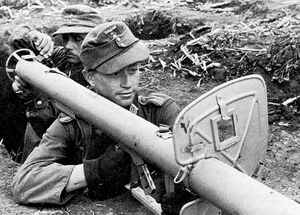Overview[]
The Yugoslav Partisans around Belgrade had gathered for a last stand with help from the Românian communist rebels. It was at this point that the Românian, Bulgarian and German forces felt they needed to end the Euro-Communist axis once and for all. Inteligency and signals analisis had shown that that the Ukraine was not compleatly done. The local rebels had deployed several heavy tanks and many 45mm anti-tank guns and many 7.62mm DT Degtyarev light machine guns around the city with much tactical concern.
The German [| Panzerkampfwagen E-100] tanks clashed with Polish rebel [| 10TP] tanks, 2 Soviet Kliment Voroshilov KV1 tanks and 6 Soviet [| PPG tankettes] outside the city of Kiev whist Polish rebel TP7 tanks and a mixture of Soviet [| T-90 self-propelled anti-aircraft gun] and fixed anti-aircraft guns in the city had made a direct assault virtually impossible. Whist Germany lay siege to the town with Panzer III tanks, supported by Elefant (German: "elephant") and Grille (German: "cricket") mobile artillery units, Românian and Bulgarian forces also entered the town 6 days in to the siege using 3 borrowed German [Panzer VIII Maus (German: "Mouse") tanks. The rebels’ 6 Polish designed TP7 tanks stood now a chance, but the rebels would engage the government forces in fierce and bloody hand to hand fighting until they surrendered on the 18th.
After the 7th day of tank clashes, in which both Romanian and Free Polish units had distinguished themselves for their exceptional valour, it was deemed that [| 800 mm calibre 'Dora' Schwerer Gustav gun] was deployed to full effect. It's 4 rounds on the would prepare the way for the final, bitterly fought, Axis assault on the 12th. Any attempted Yugoslav breakout, if it ever happened, was to countered by strategically placed German, Românian and Hungarian panzershrek crews after the 9th.
Causes of the conflict[]
The local communist resistance forces had hunkered down and began a popular rising bl. It was of a tactical necessity that the district was to be conquered to stiffle any remaining treat to both the Reich and its allies in Coatia and Romania.
Tactics[]
Result[]
An Axis victory
Political outcome[]
The Reich had made yet another major political victory over Communism in the Balkans.

